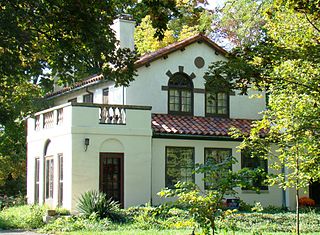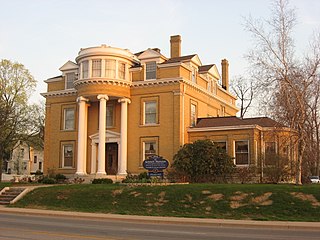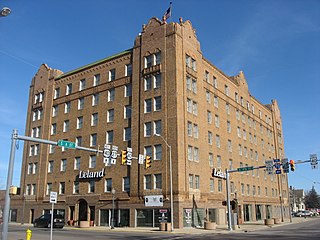
Richmond High School is a public high school in Richmond, Indiana, United States. It is the home of the Richmond Red Devils, who are members of the North Central Conference of the Indiana High School Athletic Association (IHSAA). Prior to 1939, the school was known as Morton High School in honor of Indiana's Civil War Governor, Oliver P. Morton. The current principal of Richmond High is Rae Woolpy.

The Honeywell Center in downtown Wabash, Indiana, United States, is located 47 miles (76 km) southwest of Fort Wayne, Indiana. It's a block-long arts complex featuring the Ford Theater, Clark Gallery, and Eugenia's Restaurant. The Ford Theater presents Broadway, rock, country, classical, and comedy performances.

The Reeveston Place Historic District is a neighborhood of homes and national historic district located at Richmond, Wayne County, Indiana. It was platted in 1911 on land formerly owned by the family of Mark Reeves and the district encompasses 218 contributing buildings, 1 contributing site, and 2 contributing objects. The architecture is an eclectic mix of styles including Craftsman and English cottages, and impressive homes in the Colonial Revival, Tudor Revival, Georgian, French, Spanish and Ranch styles. The original Reeves home in the Second Empire style survives as well.

The Starr Historic District is a neighborhood of historic buildings and national historic district located at Richmond, Wayne County, Indiana. The district encompasses 102 contributing buildings in a predominantly residential section of Richmond. It developed between about 1853 and 1915 and includes representative examples of Greek Revival, Italianate, Second Empire, and Queen Anne style architecture. Included in the district is a former Hicksite Quaker Meeting House, now the Wayne County Historical Museum and the Reid Memorial Presbyterian Church and Andrew F. Scott House. Other notable buildings include the Miller-Mendenhall House (1875), Dickinson Log House (1825), Starr-Cadwalader House (1861), and Clem Gaar House (1883).

The Old Richmond Historic District is a neighborhood of historic residential and commercial buildings and national historic district located at Richmond, Wayne County, Indiana. The district encompasses 212 contributing buildings located just east of the East Fork of the Whitewater River, comprising some of the earliest extant buildings in Richmond. It developed between about 1816 and 1925 and includes representative examples of Greek Revival, Italianate, and Gothic Revival style architecture. Located in the district is the separately listed Bethel A.M.E. Church. Other notable contributing buildings include the William Paul Quinn House, Elijah Coffin House (1845-1847), Henry Davis House (1856), Rankempf Cottage (1855), Hall Town House (1838), Edward Frauman House (1855), and Lydia Pierce Cottage (1858).

The Richmond Railroad Station Historic District is a group of historic commercial buildings and national historic district located at Richmond, Wayne County, Indiana.

The East Main Street–Glen Miller Park Historic District is a neighborhood of historic residential buildings and national historic district located at Richmond, Wayne County, Indiana. The district encompasses 84 contributing buildings, 11 contributing structures, and 5 contributing objects along the National Road and sometimes called Millionaire's Row. A portion of the district is recognized by the City of Richmond's Historic Preservation Commission as the Linden Hill conservation district. It developed between about 1830 and 1937 and includes representative examples of Italianate, Queen Anne, Colonial Revival, Tudor Revival, Classical Revival, and Bungalow / American Craftsman style architecture. Located in the district is the separately listed Henry and Alice Gennett House. Other notable contributing resources include elaborate iron bridges and "Madonna of the Trail" statue located in Glen Miller Park, Isham Sedgwick House (1884-1885), John A. Hasecoster House (1895), William H. Campbell House (1905), Howard Campbell House (1909), E.G. Hill House, Crain Sanitarium, and Dr. T. Henry Davis House.

Monroe County Courthouse in Bloomington, Indiana is a Beaux Arts building built in 1908. It was listed on the National Register of Historic Places in 1976. It is located in the Courthouse Square Historic District and is the seat of government for Monroe County, Indiana.

The Wayne County Courthouse is a historic courthouse located in Richmond, Wayne County, Indiana. It was built during the period 1890–93, and is in the Richardsonian Romanesque style. The building was designed by Cincinnati, Ohio, architect James W. McLaughlin and the construction was supervised by New Castle, Indiana, architect William S. Kaufman. The "U"-shaped building measures approximately 214 feet by 128 feet, and is constructed of brick faced with Indiana Limestone. It features a projecting entrance pavilion, high pitched hipped and gable roofs, large semicircular arches, and octagonal corner tower. Architectural historians Michael Tomlan and Mary Raddant-Tomlan have suggested that the Wayne County Courthouse was influenced both in terms of exterior design and elements of interior layout by Henry Hobson Richardson's Allegheny County Courthouse in Pittsburgh, Pennsylvania.

The Spencer County Courthouse is a historic courthouse located at Rockport, Spencer County, Indiana. It was designed by architect Elmer E. Dunlap and built in 1921. It is a three-story, rectangular, seven bay by five bay, Neoclassical style limestone building. The main facade features a projecting five bay central section with engaged Roman Doric ordercolumns. The interior is organized around a central rotunda topped by a shallow stained glass dome.

The Richmond Downtown Historic District is an area of primarily commercial buildings and national historic district located at Richmond, Wayne County, Indiana. The district encompasses 47 contributing buildings located along the National Road. It developed between about 1868 and 1960 and includes representative examples of Italianate, Romanesque Revival, Queen Anne, Classical Revival, and Chicago School style architecture. Located in the district is the separately listed Murray Theater. Other notable buildings include the I.O.O.F. Building (1868), Hittle Building (1878), Tivoli Theater (1926), Romey's Building (1920), George H. Knollenberg Building (1877), Kresge Building, Dickinson Building (1880), former U.S. Post Office (1905), and YMCA (1908).

Franklin College-Old Main is a historic academic building located on the campus of Franklin College in Franklin, Johnson County, Indiana. The building consists of three sections: the north wing constructed in 1847, the south wing constructed in 1855, and the middle section connecting the two wings in 1888. The wings are each three stories tall, while the middle section is four stories and topped by a bell tower and observatory. The building is in a Late Victorian / Gothic style.

Andrew F. Scott House is a historic home located at Richmond, Wayne County, Indiana. It was built in 1858, and is a two-story, cubic, Italianate style brick dwelling. It has a hipped roof topped by a cupola and kitchen wing. It features a projecting pedimented central entrance bay flanked by one-story verandahs with decorated posts. From 1977 to 2004, it was home to the Wayne County Historical Museum.

Leland Hotel, also known as the Leland Motor Inn, is a historic hotel building located at Richmond, Wayne County, Indiana. It was built in 1928, and is a seven-story, "U"-shaped, Mission Revival style reinforced concrete building sheathed in light brown brick dwelling. The building was modernized in the mid-1960s and removed or covered many of the original details. It is the tallest building in Richmond.

Murray Theater, also known as the Richmond Civic Theater-Norbert Silbiger Theater, is a historic theatre building located at Richmond, Wayne County, Indiana. It was built in 1909, and is a three-story, steel frame and brick building with Chicago School and Beaux-Arts style design influences. The auditorium was originally designed to seat 751.

Bethel A.M.E. Church is a historic African Methodist Episcopal church located at Richmond, Wayne County, Indiana. The congregation was founded in 1836. The church was built in 1854, and enlarged and remodeled in the Romanesque Revival style in 1892–1894. It is a one-story, cruciform plan, brick building with a 2+1⁄2-story bell tower. The church serves as an educational, political, and cultural center for the local African-American community.

Cambridge City Historic District is a national historic district located at Cambridge City, Wayne County, Indiana. The district encompasses 572 contributing buildings and 2 contributing structures in the central business district and surrounding residential sections of Cambridge City. It developed between about 1838 and 1939 and includes representative examples of Greek Revival, Italianate, and Federal style architecture. Located in the district are the separately listed Conklin-Montgomery House and Lackey-Overbeck House. Other notable contributing buildings include the Vinton House (1849), Opera House (1876), Western Wayne Bank, Grand Theater, Knights of Pythias Building (1899), Public Library (1936), U.S. Post Office (1940), City Building (1901), Crum-Swiggett House, Old Bertsch Foundry (1853), Presbyterian Church (1858), St. Elizabeth's Roman Catholic Church (1880), and Central School (1935).

Centerville Historic District is a national historic district located at Centerville, Wayne County, Indiana. The district encompasses 115 contributing buildings in the central business district and surrounding residential sections of Centerville. It developed between about 1817 and 1873 and includes representative examples of Greek Revival, Italianate, and Federal style architecture. During this period it was county seat of Wayne County. Located in the district is the separately listed Oliver P. Morton House. Other notable contributing buildings include Morton's Row, Lantz' Row, Archway row, Tarkington Homestead, Jacob Julian House (1857), the Mansion House (1837), the Jones House, and the American House (1838–39).

Richmond Gas Company Building was a historic commercial building located at Richmond, Wayne County, Indiana. It was built in 1855, and was a two-story, "L"-shaped, early Victorian style brick building. It had a gable roof supported by steel trusses and round and arched windows.

Starr Piano Company Warehouse and Administration Building were two historic buildings located at Richmond, Wayne County, Indiana. The Administration Building was built about 1900, and was a two-story, five sided, brick industrial building.
























